Excerpts from Jim Conrad's
Naturalist Newsletter

from the November 25, 2012 Newsletter issued from the valley of the Dry Frio River in northern Uvalde County, southwestern Texas, on the southern border of the Edwards Plateau; elevation ~1750m (~5750 ft); N29.62°, W99.86°; USA
RABBIT-TOBACCO
Back when the Rabbit-Tobacco along our dusk-walking road was flowering I didn't pay much attention to it because so many more interesting and eye-catching plants were blossoming at the same time. Rabbit-Tobacco, after all, is basically a weed found throughout eastern North America and its flowers are tiny, pale things. However, now that the fall wildflowers have mostly faded here, turning brown and brittle, and falling to the ground despite our have had no frost, and because this week I've had a chest cold, suddenly the Rabbit-Tobacco along the road took on a new interest.
First, our Rabbit-Tobacco -- sometimes called Cudweed, Sweet Everlasting, and other names -- is PSEUDOGNAPHALIUM OBTUSIFOLIUM, a member of the Composite or Sunflower Family. That's it at the top of this page.
Note that the plants' leaves are dry and curled up, and that what could be bunches of white flowers actually are clusters of composite-flower heads long past their flowering and fruiting seasons. The plants' white "heads" whitish, chaffy involucres empty of their contents. You can see a close-up of some heads on conspicuously white-hairy stem branches below:

A little to the left and below the center of that picture you can see a parachuted, cypsela-type fruit suspended between two inflorescence branches, looking like a tiny milkweed seed.
Also you can see below that the plant's white hairiness continues onto the lower stem and covers leaf undersides:

Now to the matter of my having had a chest cold this week. I can't see Rabbit-Tobacco without remembering my experiences among the Tzotzil-speaking indigenous folks of upland Chiapas, southern Mexico. Traditionally a member of this group of plants, maybe even the very same species, has been used medicinally to cure respiratory ailments. Down there it's called Gordolobo, or "Fat Wolf," and in the highlands where chest colds are common and the plant grows profusely in pastures and along roads, Gordolobo is a very important medicinal herb.
So, this week on one of our evening walks I broke off a good-sized sprig of Rabbit-Tobacco and the next morning put the whole thing into a saucepan of boiling water. The water very quickly turned yellow, and then dark amber. I remember the teas made in Chiapas as being bright yellow, so I figured I'd used too much Rabbit-Tobacco, and diluted it until it was the right hue of yellow. Then I drank it.
Maybe my chest cold was due to break up anyway, but the fact is that within an hour my sinuses had unclogged for the first time in days and my chest didn't feel nearly as congested as it had earlier. You just never know how much you're imagining these things, and how much a medicine is genuinely helping you, but it sure seemed like to me that drinking two quarts (liters) of Rabbit-Tobacco tea helped alleviate my cold symptoms.
In fact, ethnologists have documented the use of Rabbit Tobacco for treating asthma among the Rappahannock, Eastern Cherokee and other Native American groups. In their field guide to medicinal plants in eastern and central North America, Steven Foster and James Duke identify Rabbit Tobacco as a remedy for sore throats, pneumonia, colds, fevers, upset stomach, abdominal cramps, asthma, flu, coughs, rheumatism, leukorrhea, bowel disorders, mouth ulcers, hemorrhage, tumors, and say that it has been used as a mild nerve sedative, a diuretic, and an antispasmodic.
And it can be smoked as a tobacco substitute.
from the December 9, 2012 Newsletter issued from the valley of the Dry Frio River in northern Uvalde County, southwestern Texas, on the southern border of the Edwards Plateau; elevation ~1750m (~5750 ft); N29.62°, W99.86°; USA
RABBIT-TOBACCO TESTIMONIAL
This week I heard from JoAnn in Georgia who when reading the above Newsletter entry had had a husband with sinus problems. Getting interested, she'd researched the matter more on the Internet, then decided to try the cure of a Rabbit-Tobacco tea. She reports that her patient, "... since drinking the rabbit tobacco tea this past week, has been able to breath better through his nose than in a long, long time. Has had sinus difficulties for years. Further, I noted that while he taught the Bible class this past Wednesday evening he whipped out his trusty handkerchief not one single time!"
Thinking that as fall and winter rains drench the Rabbit-Tobacco still standing and cause it to lose much of it potency, and supposing that we haven't seen the last of sinus and lung problems here, I picked a nice armload of the herb and hung it in a shed, creating an upside-down bouquet that's very pleasant to look at each time I see it. It's shown below:
